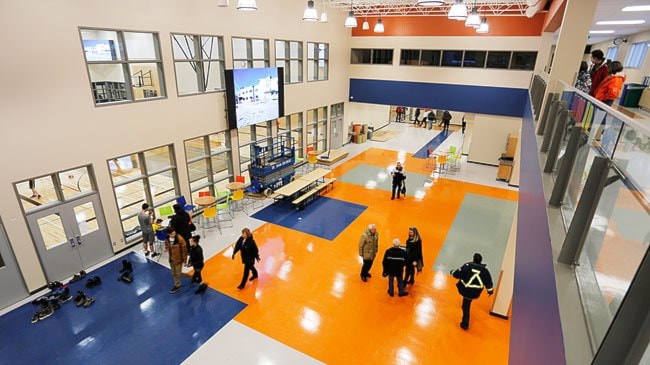Peter Grundmanis remembers a cool spring day when the doors were open inside the F.H. Collins Secondary School gym and the students were practising archery.
All of a sudden, a gopher ran in and made a mad dash for the bleachers.
“You can’t imagine what 12 kids armed with bow and arrows would do in that situation,” he told a packed audience in the gym on Thursday afternoon, pointing to the spot where it happened.
“There were more gouges on the floor there than anywhere else.”
The gopher escaped unscathed.
It was one of several anecdotes Grundmanis recalled from his 25 years as a teacher at the school.
He acted as the master of ceremonies for hundreds of students and staff, current and former, young and old, who packed into the gym to celebrate the closing of the 52-year-old building.
They walked down memory lane together as they watched old pictures and videos displayed on a big screen.
One segment featured the school’s well-known alumni, including renowned artist Ted Harrison, actress Amy Sloan and former Olympian Jim Boyd.
A bevy of former students such as Ruth Massie, Carl Sidney and Roger Kyikavichik have also gone on to become First Nation chiefs throughout the territory.
Another highlight was a mock music video created using hits from every year between 1963 and 2015.
The camera weaved its way through the hallways and classrooms of the school, as students and staff lip-synced and danced to the classic tunes.
For over 30 years, it was the city’s only high school.
When it opened in 1963, it had 20 teachers and 315 students.
Yukon Commissioner Doug Phillips remembers that year. He came over to F.H. Collins as a Grade 9 student from Whitehorse Elementary High School.
But similarly to 2015, construction of F.H. wasn’t completed yet, he said.
“We were on shift work from September to December because they didn’t move us in permanently until January,” he added.
“So a bunch of us would go in from 7:30 a.m. until noon every day. We didn’t get a lot done that first semester.”
Many former F.H. Collins students have made an impact on a national level, Phillips said.
As Yukon’s education minister in the early 1990s, he remembers going to a conference in Ottawa with his provincial counterparts.
He sat next to Richard Nerysoo, from the Northwest Territories, and pointed something interesting out to him.
“Do you realize there’s 12 of us in this room making national education policy and two of us are grads from F.H. Collins?” Phillips asked.
NDP MLA Kate White said her favourite memories of the school were in the band room.
Her music teacher, Ross Peterson, would take the class to international competitions in Hawaii and San Francisco.
“The room itself has a massive amount of meaning for me,” she said.
“Art kids don’t necessarily fit into the mainstream of high school. So for me, the band room was that safe spot.”
As Whitehorse’s oldest school, gophers weren’t the only critters to roam the hallways over the years.
Anyone attending the school in the 1990s would remember thousands of silverfish too, White said.
By the mid-1990s the student body had grown to about 1,000 students.
Before the cafeteria opened there was a limited lunch menu available, Grundmanis remembers.
Different clubs would try to fundraise by either selling hot dogs or grilled cheese sandwiches. But one day, one staff member thought it would be nice to order take-out pizza for a change.
So they tried to figure out how many pizzas it would take to feed 1,000 students.
“We assumed they’d eat one-third each, so we ordered 300 pizzas, and figured we’d make some money selling it by the slice,” Grundmanis said.
They only sold 30 pizzas that day.
The replacement of F.H. Collins was fraught with just as many planning mistakes.
For years, the Yukon government insisted that plans to build a new school were on time and on budget. But the project continued to be delayed and costs continued to rise.
Before the 2011 election, Premier Darrell Pasloski hosted a groundbreaking ceremony on the building, announcing it would open in August of 2013 for a total project cost of $52.5 million.
Costs quickly spiralled out of control, as the government continued to promise features it did not budget for such as geothermal heat and a temporary gym during construction.
Ultimately, the plans were scrapped and swapped for new, downsized designs.
The new school, which is 18 per cent smaller than the old one, looks spacious, bright, and at least for now, gopher-free.
The high ceilings and wide video screen in the main lobby resemble what you’d find in a modern museum.
As the ceremony began on Thursday, there was a touch of nostalgia in Grundmanis’s voice.
“It’s time to close the covers on this book,” he said.
“But in the book that you’ve enjoyed reading, you’ve come to love the characters and the setting. You’ve come to appreciate everything so there’s no harm, there’s only joy in looking at the past.”
Contact Myles Dolphin at
myles@yukon-news.com
